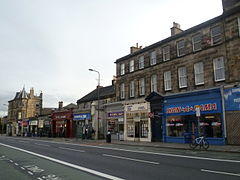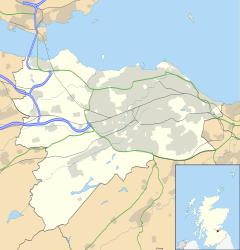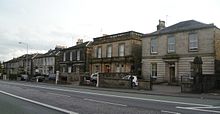| Newington | |
|---|---|
 Newington Road | |
Location within Edinburgh | |
| Council area | |
| Lieutenancy area | |
| Country | Scotland |
| Sovereign state | United Kingdom |
| Post town | EDINBURGH |
| Postcode district | EH8 |
| Postcode district | EH9 |
| Dialling code | 0131 |
| Police | Scotland |
| Fire | Scottish |
| Ambulance | Scottish |
| UK Parliament | |
| Scottish Parliament |
|
Newington is a largely residential area around Newington Road in Southern Edinburgh, Scotland.
Location
Newington Road is one mile South on the A7 main road from the East end of Edinburgh's principle street, Princes Street. Newington is bounded to the east by Dalkeith Road, to the west by Causewayside, to the north by East and West Preston Street, and to the south by East and West Mayfield. It contains the smaller enclave of Blacket within its centre. Newington lies close to The Meadows, and Holyrood Park.[1]
History
It lies on the area formerly covered by the Burgh Muir, which was gifted to the City by David I in the 12th century. The muir continued eastwards into what is now known as the Prestonfield district. The Grange lies to the west.[2]
Even after the 1586 consolidation of land rights over the Burgh Muir, the area remained largely rural. The Newington Estate was purchased sometime before 1672 by John Lauder, a Baillie and Treasurer of Edinburgh, who thereafter took the landed designation "of Newington", until he became Sir John Lauder, 1st Baronet of Fountainhall. This family later also became possessed, by marriage, of the estate of The Grange, Edinburgh.
With overcrowding of the city centre being initially alleviated by expansion to the north, creating the New Town, via the North Bridge, many people felt that the New Town, elegant as it was, did not offer privacy and intimacy, and so, when the South Bridge was built in 1788, parts of Newington became available for development. From the 1820s a programme of building began, with Newington House (by James Gillespie Graham) as its centrepiece.[3] The wider area was feued many for detached or semi-detached villas, with large gardens. These were aimed at the richer Edinburgh merchants and professionals. The northern district (closer to the city centre) was built more densely including tenements. In the 1860s Newington House was home to Duncan McLaren.[4]
As with much of Edinburgh, the bulk of the 19th century development still exists and most is designated as official conservation area: Blacket Conservation Area,[5] Waverley Park Conservation Area[6] and Craigmillar Park Conservation Area.[7] The northern part of Newington, around South Clerk Street, lies in the South Side Conservation Area.
Retail services
Buildings flanking the A7 in Newington are commercialised, containing various retail businesses and pubs, as well as an NHS dentist on Mayfield Road. These commercial premises are mostly the ground floor of otherwise residential tenement buildings. Continuing the A7 south, Newington Road is renamed Minto Street and then Craigmillar Park. These are dominated by small guest houses, contained within some of the larger villas.
Education
Pollock Halls of Residence lies just outside Newington. But the northern section of Newington provides numerous flats for students, largely due to the area's proximity to both of the University of Edinburgh's main campuses: George Square and King's Buildings.
Architecture
Local buildings of interest include:[8]
- Longmore Hospital on Salisbury Place by John More Dick Peddie - now the headquarters for Historic Environment Scotland
- Former Royal Blind School, off Craigmillar Park, by Charles Leadbetter - proposed for residential conversion
- Suffolk Halls - now converted to flats
- Newington Cemetery
- Edinburgh Synagogue, Salisbury Road (1932)
- St Columba's Catholic Church Edinburgh 7 Upper Gray Street.[1] Renaissance style by architect Rhoderic Cameron (1860- 1928)
Demographics
| Race | Newington | Edinburgh |
|---|---|---|
| White | 86.6% | 91.7% |
| Asian | 9.9% | 5.5% |
| Black | 0.9% | 1.2% |
| Mixed | 1.4% | 0.9% |
| Other | 1.2% | 0.8% |
References
- ^ Edinburgh A-Z
- ^ Grant's Old and New Edinburgh
- ^ https://canmore.org.uk/site/129890/edinburgh-blacket-avenue-newington-house
- ^ Edinburgh Post Office Directory 1865
- ^ Blacket Conservation Area Character Appraisal, from City of Edinburgh Council.
- ^ Waverley Park Conservation Area Character Appraisal, from City of Edinburgh Council.
- ^ Craigmillar Park Conservation Area Character Appraisal, from City of Edinburgh Council.
- ^ Buildings of Scotland: Edinburgh, by Gifford, McWilliam and Walker
External links
- Bartholomew's Chronological map of Edinburgh (1919)
- Map sources for Newington, Edinburgh

